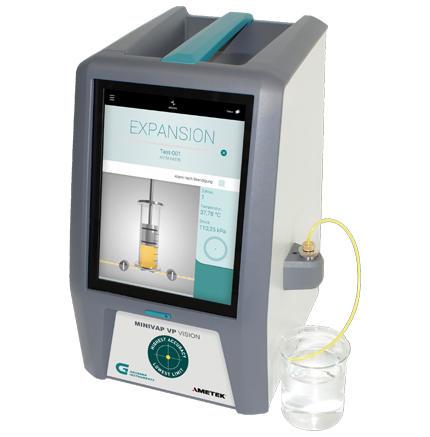
Highest Accuracy – Lowest Limit: Low Volatility Model MINIVAP VPL VisionProduct | Small | MINIVAP VPL Vision While the standard VP model is designed to sustain pressures up to 20 bar, some applications require increased measurement sensitivity for samples with a very low volatility. These applications include e.g. the measurement of Diesel, Oils or Flavors […]
| ASTM D6378 | Vapor Pressure of Gasoline and Petrochemicals (VPx) Grabner´s “Triple Expansion Method” with determination of the dissolved air in the sample. No cooling and air Saturation required! |
| ASTM D5191 | DVPE Dry Vapor Pressure Equivalent (w/ EPA and CARB correlation formulas) Standard “Mini-Method” measured against vacuum and a correlation formula for the calculation of the DVP. Requires sample preparation, including cooling of the sample to 0°C (32°F) and triple air saturation prior to the measurement. |
| ASTM D6377 | Vapor Pressure of Crude Oil (VPCRx) “Single-Expansion Method” for vapor pressure of Crude Oil developed by GRABNER INSTRUMENTS. Better precision than classical ASTM D323 RVP method, ASTM correlation formula to D323 available. Does not require sample preparation: Saves time, increases precision and eliminates operator bias. |
| ASTM D6897 | Vapor Pressure of LPG up to 2000 kPa Easy, quick, fully automatic and accurate measurement of liquefied petroleum gas. Replaces the manual bomb method ASTM D1267. ASTM D6897 eliminates manual operation and cleaning and minimizes sample waste. Yields results in excellent correlation with ASTM D1267, but with a highly improved precision. |
| ASTM D5188 | V/L-Ratio (TV/L) Determines V/L ratio of non-viscous liquids including hydrocarbons like gasoline, solvents and other highly volatile compounds. Instrument performs fully automatically, providing results in minutes. No additional equipment is required. |
| Fast Mode™ | ASTM D5188 & D5191 Fast Mode™ Method Runs ASTM D5188 and D5191 directly after each other. |
| EN 13016 – 1 | Air Saturated Vapor Pressure |
| EN 13016 – 2 | Absolute Vapor Pressure |
| IP 394, 409, 481 | IP Methods for gasoline and crude oil |
| JIS K2258-2 | Japanese standard method for gasoline |
| SHT 0769 | Chinese standard method for gasoline |
| SHT 0794 | Chinese standard test method for Vapor Pressure of Petroleum Products (Mini Method) |
| SNT 2932 | Determination of Vapor Pressure of Chemicals – Triple Expansion Method |
| GOST 52340 | Russian / CIS standard method for crude oils |
| “VOC” Methods | Direct and Indirect Low Volatility Methods Static methods for determining the absolute vapor pressure required for safety data sheets. Both methods yield results comparable to the static ASTM D2879 Isoteniscope method, but do not require sample evacuation prior to testing. |
| TVP | True Vapor Pressure TVP of Crude Oils (FW 2.0) |
| Custom | Customized Single and Triple Expansion Methods |